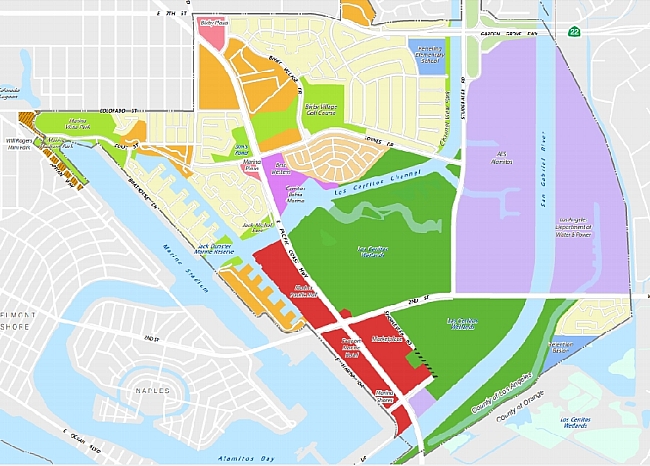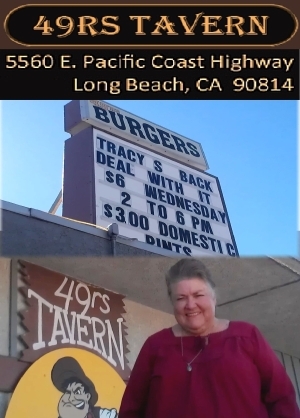In a nearly three-hour hearing in June 2017, LB's Mayor-chosen/Council-approved Planning Commission voted without dissent to recommend that the Council approve allowing up to five story buildings instead of the current three stories in the red areas in the map below...but with up to seven stories possible (for a hotel) on up to 20% of the area on the west side of PCH north of 2nd St. (Marina Pacific area) where city staff's text indicates buildings with roughly 20% of project areas "may be considered" for the following:
Hotel or mixed use buildings containing hotel as a portion of their use, if it is demonstrated that significant community amenities are provided, above and beyond those that are required under the maximum height of five stories. Amenities can include plaza spaces, enhanced landscaping, public artwork, public parking, (See Section 5.7a Mixed Use Community Core height and FAR incentives.) Seven story buildings are intended to be an exception to the building massing for all structures within a project. The majority of the buildings within the Mixed-Use Community Core designations are intended to be constructed at or near the maximum base height. Building footprint of all buildings using seven stories cannot exceed 20% of the total acres in the MU-CC.

City staff's June agendizing memo noted that traffic impacts were the "most common concern expressed by the public." It said the reduced intensity alternative "results in the least potential traffic increase between the existing PD-1 and SEASP. Through reductions in residential and particularly commercial development, the reduced intensity alternative results in impacts comparable to buildout with the existing PD-1 regulations.
| Scenario | Trips (external) | Change from existing |
|---|---|---|
| Existing | 65,741 | -- |
| Proposed | 96,299 | 30,568 |
| No Project (adopted PD-1) | 86.564 | 20,833 |
| Reduced Intensity Alternative | 86,964 | 20,233 |
Under the "reduced intensity alternative," city staff predicts a capacity of 2,584 new dwelling units, an increased population of 4,018 persons and commercial employment of 307,071 sq. feet. The Planning Commission also approved an accompanying draft EIR that includes a "statement of overriding considerations" acknowledging that some environmental impacts of the SEASP rezoning, including traffic, will be significant but can't be feasibly mitigated.
Sponsor | Sponsor |
At the June Planning Commission meeting, the Los Cerritos Wetlands Land Trust (through an attorney) asked city staff to explore how to apply a "baseline land use allocation policy" for the chronically polarizing SEASP land revision. A "baseline land use allocation policy" would be a potential game-changer: a development approval process used in Santa Monica and some other cities that lets the City apply flexible, real-world results instead of consultant or city staff predictions on the impacts of proposed developments.
The group's proposal (made verbally and in writing) drew a polite but less than warm initial staff response. City Hall's Advance Planning Officer Christopher Koontz indicated he'd only learned of it the night before, stopped short of flatly ruling it out but said it wouldn't consistent with what the City of Long Beach has done and is now doing (transcript below.)
Public speaker Kerrie Aley was first to publicly urge that the city apply baseline allocation development. She said that policy could provide "a fail safe...where there is a baseline development plan. Should traffic exceed the predictions or if mitigations are not provided, development can be capped at this level." She was later followed by Attorney Michelle Black (with the firm of Chatten-Brown and Carstens) representing the Los Cerritos Wetlands Land Trust, who (in addition to presenting written testimony) stated at the public podium:
We suggest incorporation of a baseline land use allocation policy...used in Santa Monica, Livermore among other cities. Such a policy would set a baseline allocation for the amount of development allowed under SEASP and provide for extra development intensity up to a certain cap for projects that provide additional community benefits. Wetlands enhancement viewing areas, sustainable building projects, sustainable energy sources, the list goes on. The extra intensity under such a policy would be awarded annually...and it would be discretionary, thereby allowing the City to evaluate how SEASP development is going. As it goes over time before deciding whether extra intensity could or should be allowed. If impacts are less than anticipated in the SEASP EIR, then extra intensity could be awarded to future projects. If impacts are greater than anticipated in the EIR, extra intensity could be withheld or there'd be time to craft additional mitigation. This approach grants the City greater flexibility and greater control while incentivizing development of better projects. A baseline land use allocation policy would satisfy CEQA's requirements to fully mitigate remaining environmental impacts and we ask that staff explore how such a policy could be implemented in SEASP.
Sponsor |  |
Asked by Planning Commission member Mark Christoffels about using a "baseline land use allocation policy," City Hall's Advance Planning Officer Christopher Koontz replied:
Mr. Koontz: I did get a chance to review that when I received that last night. And it's important to understand what that is. That's the equivalent of doing a development agreement on every case and negotiating a set of community benefits on every case. It's inconsistent with what we're trying to do here, the direction from City Council not just on this project but in general and the Economic Blueprint is to bring certainty and established procedures to the development process. The approach taken in Santa Monica was to lower or freeze the development potential to all sites, and then have a menu of different community benefits and then have a negotiation based on the specifics of that project and then bring that before the Planning Commission and then try to come to an agreement and then bring it to their City Council.The other notion that was prescribed as the idea that we'd be annually monitoring and we're all for annual monitoring but I have to say the idea that we could update the plan every year based on an objective measures and then have the community buy-in on that and then apply that to changes in land use regulations, it took us three years to get to this point and then we're going to process the projects case by case. So I understand the motivation but I fail to see how that could really be applied in this city or how it would serve our goals here.
Sponsor | Sponsor |
Long-time locals say the area's current zoning (SEADP, adopted in late 1970s) was intended to protect SE LB's low-rise coastal zoning in exchange for allowing greater density downtown. Pro-development advocates argue that the city's SE gateway needs and deserves upgraded and more intense commercial activity. Others respond that 2nd/PCH is already LB's most congested intersection.
The Sept. 19 Council vote comes as city-staff also proposes to rewrite the rest the city's Land Use Element to invite increased density and building heights in various areas citywide. The proposed Land Use rewrite has triggered public push-back on density from Wrigley to East Long Beach. Following a bruising August 17 Planning Commission meeting [where 29 speakers variously opposed advancing maps showing proposed increased density], Mayor Garcia asked and city staff agreed to slow the maps' advance to seek more "public input" (with no guarantee of the outcome that a Council majority will decide.)
Proposals to increase density -- including SEASP, the proposed Land Use Element rewrite and SB 35 -- were hot topics at a
The Council's Sept. 19 vote on SEASP will (via an appeal or otherwise) ultimately go to the CA Coastal Commission, one of whose members is 7th dist. LB Councilman Roberto Uranga. Five of LB's nine Council incumbents (Gonzalez, Price, Mungo, Uranga and Richardson) plus Mayor Garcia (the latter with a veto but not a vote) will face voters in April 2018.
Sponsor |
blog comments powered by Disqus
Recommend LBREPORT.com to your Facebook friends:
Follow LBReport.com with:
RSS |
Contact us: mail@LBReport.com





Hardwood Floor Specialists
Call (562) 422-2800 or (714) 836-7050
